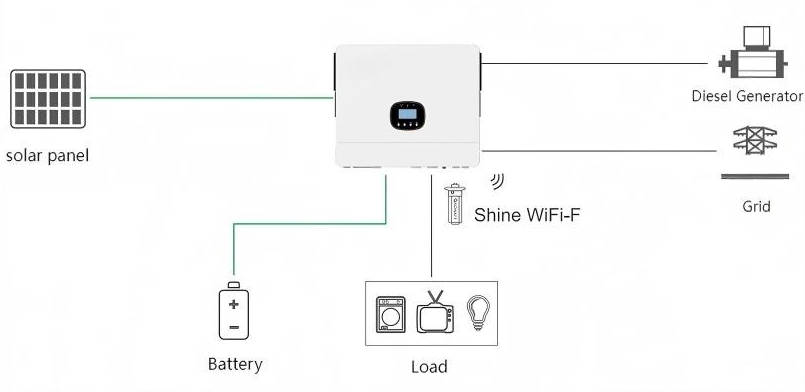Blog
How to Choose an Off-Grid Inverter?
Off-grid Inverters must have independent energy storage control to directly drive the load and manage battery charging and discharging. When selecting an off-grid inverter, consider the following:
① Rated power: Must match the PV array and peak load power.
② Number of MPPTs: Suitable for complex PV deployments.
③ Charging mode: Supports MPPT PV charging and battery management.
④ Protection functions: Includes overvoltage, overcurrent, overtemperature, and reverse polarity protection.
⑤ Support for diesel generator connection to reduce external equipment.
How to choose between lead-acid and lithium-ion batteries?
Lead-acid batteries are low-cost and suitable for budget-constrained and space-constrained applications (such as rural household power supply). Lithium-ion Batteries have high energy density and long lifespan and are suitable for space-constrained or demanding applications (such as communication base stations and emergency power supplies).
How to Calculate System Capacity?
Appropriate battery capacity is determined based on the needs of the application scenario.
① Self-generation and self-consumption scenarios: Calculate the capacity based on a comprehensive consideration of PV power generation, daytime electricity consumption, and nighttime electricity consumption. For example, if a household's photovoltaic power generation is 17.5 kWh per day, with 5 kWh of electricity consumed during the day and 15 kWh at night, the battery capacity should be at least (17.5 - 5) kWh = 12.5 kWh, and should not exceed the nighttime power consumption (to avoid redundancy).
② Backup power scenario: Calculate based on the longest power outage duration and load power. For example, if the site needs to support four 550W fans for four hours, the battery capacity must be ≥ 4 × 550W × 4h = 8.8 kWh. For a 51.2V system, with a 1C battery configuration, the battery capacity must be at least 172 Ah.
How to use it with a diesel generator?
A hybrid system can compensate for power shortages during rainy days: ① Logic: Normally, power is provided by PV and Energy Storage. When the battery SOC is ≤20% and there is no sunlight (a configurable threshold), the diesel generator automatically starts, powering the load while also charging the battery. When the battery SOC is ≥80%, the generator automatically shuts down, with the battery/PV supplying the load. ② Equipment Requirements: The diesel generator power must match the total load power plus the battery charging power (e.g., 5kW load, 3kW battery charging, generator power ≥8kW).
How to resolve "load overload" issues?
① Temporary Solution: Disconnect non-essential loads (such as high-power motors and electric water heaters) and wait for the inverter to reset. If the problem persists, perform a no-load test to determine if the inverter is faulty.
② Long-term Solution: Determine whether the total power exceeds the limit. Replace with a larger inverter or adjust power usage to avoid starting and stopping multiple large devices simultaneously.
③ Design optimization: Count the load types in advance, pay attention to the inrush current of inductive loads (such as pumps and air conditioners), and select the inverter according to the actual peak value.
